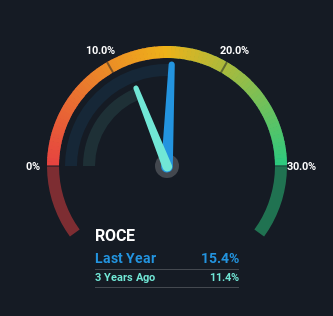Gokul Refoils & Solvent (NSE:GOKUL) Shareholders Will Want The ROCE Trajectory To Continue
If we want to find a stock that could multiply over the long term, what are the underlying trends we should look for? In a perfect world, we'd like to see a company investing more capital into its business and ideally the returns earned from that capital are also increasing. Put simply, these types of businesses are compounding machines, meaning they are continually reinvesting their earnings at ever-higher rates of return. Speaking of which, we noticed some great changes in Gokul Refoils & Solvent's (NSE:GOKUL) returns on capital, so let's have a look.
Understanding Return On Capital Employed (ROCE)
For those who don't know, ROCE is a measure of a company's yearly pre-tax profit (its return), relative to the capital employed in the business. The formula for this calculation on Gokul Refoils & Solvent is:
Return on Capital Employed = Earnings Before Interest and Tax (EBIT) ÷ (Total Assets - Current Liabilities)
0.15 = ₹539m ÷ (₹8.5b - ₹5.0b) (Based on the trailing twelve months to December 2023).
Thus, Gokul Refoils & Solvent has an ROCE of 15%. That's a pretty standard return and it's in line with the industry average of 15%.
View our latest analysis for Gokul Refoils & Solvent

Historical performance is a great place to start when researching a stock so above you can see the gauge for Gokul Refoils & Solvent's ROCE against it's prior returns. If you're interested in investigating Gokul Refoils & Solvent's past further, check out this free graph covering Gokul Refoils & Solvent's past earnings, revenue and cash flow.
How Are Returns Trending?
We like the trends that we're seeing from Gokul Refoils & Solvent. The data shows that returns on capital have increased substantially over the last five years to 15%. The amount of capital employed has increased too, by 24%. The increasing returns on a growing amount of capital is common amongst multi-baggers and that's why we're impressed.
On a side note, Gokul Refoils & Solvent's current liabilities are still rather high at 59% of total assets. This effectively means that suppliers (or short-term creditors) are funding a large portion of the business, so just be aware that this can introduce some elements of risk. While it's not necessarily a bad thing, it can be beneficial if this ratio is lower.
In Conclusion...
All in all, it's terrific to see that Gokul Refoils & Solvent is reaping the rewards from prior investments and is growing its capital base. Since the stock has returned a staggering 440% to shareholders over the last five years, it looks like investors are recognizing these changes. Therefore, we think it would be worth your time to check if these trends are going to continue.
Gokul Refoils & Solvent does have some risks, we noticed 4 warning signs (and 1 which doesn't sit too well with us) we think you should know about.
While Gokul Refoils & Solvent may not currently earn the highest returns, we've compiled a list of companies that currently earn more than 25% return on equity. Check out this free list here.
New: Manage All Your Stock Portfolios in One Place
We've created the ultimate portfolio companion for stock investors, and it's free.
• Connect an unlimited number of Portfolios and see your total in one currency
• Be alerted to new Warning Signs or Risks via email or mobile
• Track the Fair Value of your stocks
Have feedback on this article? Concerned about the content? Get in touch with us directly. Alternatively, email editorial-team (at) simplywallst.com.
This article by Simply Wall St is general in nature. We provide commentary based on historical data and analyst forecasts only using an unbiased methodology and our articles are not intended to be financial advice. It does not constitute a recommendation to buy or sell any stock, and does not take account of your objectives, or your financial situation. We aim to bring you long-term focused analysis driven by fundamental data. Note that our analysis may not factor in the latest price-sensitive company announcements or qualitative material. Simply Wall St has no position in any stocks mentioned.
About NSEI:GOKUL
Gokul Refoils & Solvent
Engages in the seed processing, solvent extraction, and refining edible and non-edible industrial oils in India and internationally.
Proven track record with mediocre balance sheet.
Similar Companies
Market Insights
Community Narratives


Recently Updated Narratives

TAV Havalimanlari Holding will fly high with 25.68% revenue growth


Fiducian: Compliance Clouds or Value Opportunity?


Q3 Outlook modestly optimistic
Popular Narratives


MicroVision will explode future revenue by 380.37% with a vision towards success


The company that turned a verb into a global necessity and basically runs the modern internet, digital ads, smartphones, maps, and AI.



